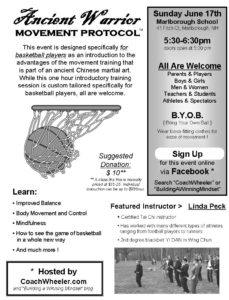This blog article is dedicated to Eddie Siebert. Coach Wheeler, back when he was Player Wheeler, played with (and won championships) with him. Eddie taught me about the importance of “game face”. His famous quote, before every game, was “Get Your Game Face On!”
The video below from BasketballBrain.com is a great overview of the 3 types of approaches used by basketball players and it is worth watching. Check it out…
The 3 types of basketball game face from the video are 1) Joyous, 2) No Expression and 3) Mean, Fierce or Angry. The video has some excellent NBA examples of each one so you can learn more about each one. The key to all of them is that they bring a focus to your game and just like you can improve your mood by physically smiling, the way you move your face can impact the way you feel and how you play the game.
Which one are you?
First, let me say that you NEED a Game Face. It is a sign to your team mates, your coach and even your opponents that you are serious about winning the game. The question is… Which game face works for you? I should also add that you may tap into different ones depending on the game situation and how you or your team is playing. Sometimes they need a “kick in the pants” and a Fierce Game Face might be needed. Or you might be getting shut down by the other team’s defense so you could break through and show some Joy (and your confidence) when you school them.
It is contagious!
Your attitude, demonstrated through your game face and how you play, is contagious and is an important way you can influence your team. Michael Jordan set a very high standard for the Bulls and they rose to the challenge. (The Washington Wizards… not so much.) What attitude are you bringing to your team? Are you making the practices more effective? Or just walking through them and not getting better? Your attitude & how you express it should help your team, not slow them down or give them reasons to doubt your commitment to winning.
 Want to learn more about Attitude?
Want to learn more about Attitude?
Visit the “Attitude” page with all the articles about Attitude from the Building a Winning Mindset Blog ! It is important and there are lots of ways to look at it.
Think about it…
What kind of attitude do you want to bring to the game? How are you going to step up so you can defeat the competition? The choice is yours. Now, GO GET YOUR GAME FACE ON !






